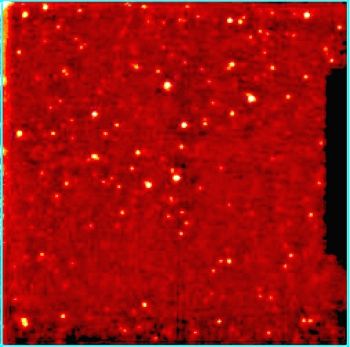AKARI Results
AKARI confirms an era of intense active star formation in the Universe
- Deep sky survey in 15 micrometre infrared light -
The Near- and Mid-Infrared Camera (IRC) onboard AKARI has carried out a wide area deep survey in 15 micrometre infrared light, detecting many galaxies. This result indicates that a phase of intense active star formation took place in the Universe, lasting several billion years over 6 billion years ago.
Galaxies in which active star formation is taking place emit most of their energy as infrared radiation from the interstellar material heated by the light from the young hot stars. The light we observe from the distant galaxies, in reality, left the galaxies a long time ago. The light is stretched or red-shifted due to the expansion of the Universe, and is observed at longer wavelengths to which they were initially emitted. Infrared observations with the Infrared Space Observatory (ISO), the European infrared astronomy satellite launched in 1995, revealed that the number of faint, distant galaxies increased drastically when observed at 15 micrometres. This can be explained by the redshift effect, where the original light was emitted from the galaxies at a wavelength of 7 micrometres around 6 billion years ago. During the course of its journey across the Universe to us, the light was red-shifted to the longer wavelength of 15 micrometres. It is now known that the intensity of infrared radiation from young galaxies is high around a wavelength of 7 micrometres due to the characteristic emission from organic materials in the interstellar medium. This emission feature is stronger in regions where stars are actively being formed. Thus, the results of the ISO observations were interpreted as evidence that active star formation took place at this epoch in the history of the Universe. However intriguing this result may be, the conclusion was drawn from observations of a very small area of the sky containing only 24 galaxies detected in the infrared. Therefore, it is obviously very important to extend these investigations to measure how many galaxies exist at each distance in order to understand the evolution of the galaxies throughout the history of the Universe.
Figure 1 shows the results of the deep survey observations at 15 micrometres by the Near- and Mid-Infrared Camera (IRC) onboard AKARI. The observed area is about three times wider than that of ISO. AKARI detected around 280 galaxies (10 times more than the ISO survey) in this region. This is the deepest survey at 15 micrometres ever made over this kind of sky area. AKARI's observations concretely confirm the increase of the number of galaxies at 15 micrometres implied by the earlier ISO observations. Moreover, AKARI also discovered comparable numbers of even fainter galaxies, leading us to an important conclusion that the star formation activity was already high at times even earlier than 6 billion years ago.
AKARI is performing similar deep surveys over the entire wavelength range from 2 to 24 micrometres. Such multi-wavelength data will provide a definitive description of the dusty galaxy evolution over the life of our Universe.

Figure 1: The AKARI deep sky survey at 15 micrometres by the Near- and Mid-Infrared Camera (IRC). White points are all thought to be distant galaxies. The image size is about 10 arcmin squared.
This research is carried out by Dr. T.Wada, Dr. S. Oyabu (ISAS/JAXA) and collaborators.
Materials
- Figure 1 (© ISAS/JAXA)





